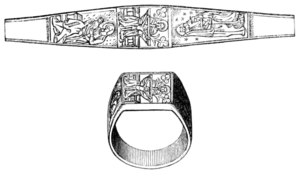style and mode of treating the figures has been considered similar to the early manner of Rothenhamer. One represents the Annunciation; Joseph appears in the back-ground, asleep under a tree: the subject of the other is the Adoration of the Magi,—a pompous procession of many figures. This peculiar intarsiatura of mother-of-pearl was practised in Spain, and very probably by Flemish artists (the style of art being of that school), who were much encouraged in Spain about the close of the sixteenth, and early part of the seventeenth century.—Also a relic of David Garrick,—his silver seal with his initials.
By Mr. Octavius Morgan.—A square plaque, of early Limoges enamel, in the Byzantine manner, exceedingly curious both for design and rich colouring. Subject: Samson bearing the gates of Gaza. Twelfth century.—A knife; the blade (4 inches long) etched and gilt; it has a long curved handle (11 inches) tapering to a point. It resembles the penknife which appears in illuminations, in the left hand of the scribe, and resting on the parchment. Probably, it was part of the etui, or set of knives, the official appendage of the carver in noble houses (trencheator, or chevalier trenchant). Several specimens of iron work and damaskined work, of the sixteenth century, including caskets of iron, one inlaid with silver, of fine Milanese work.—A water-vessel of an Oriental hookah, of cast zinc, with silver bands elegantly engraved and enriched in part with inlaid turquoises and black enamel. It is interesting as an example of the early use of zinc in the East, for such ornamental purposes.
By the Rev. S. Blois Turner.—A beautiful gold ring, of fifteenth century work, found at Orford Castle, in Suffolk. On the facet is engraved a representation of the Trinity, the Supreme Being supporting a crucifix; on the flanges are St. Anne instructing the Virgin Mary, and the Mater Dolorosa. These designs were probably enamelled. Mr. Turner has kindly presented to the Institute the accompanying illustration.
By Mr. Charles Bail.—A massive signet-ring, of silver, parcel-gilt: the impress is the new moon, with a human face quaintly introduced in the crescent. Date, fifteenth century.
By Mr. Parsons.—An exquisite gold ring (fifteenth century), found within the precinct of Lewes Priory. It is delicately chased with the following subjects: On the facet, the Virgin and Child; on one side, the Emperor Domitian, on the other, St. Pancras; on the flanges are represented the Holy Trinity, and St. John, with the Holy Lamb. The work was originally enriched with transparent enamel.

